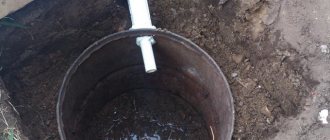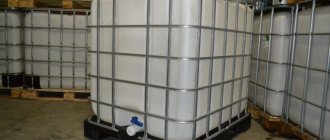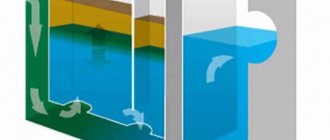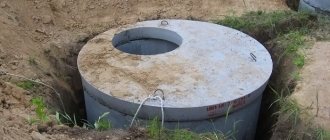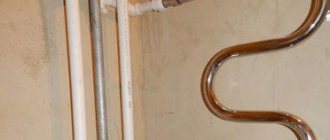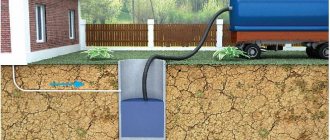Selection of tires for septic tanks and other materials
It is desirable that they be of large diameter and maximum width - from heavy vehicles - there are enough of them at truck tire shops. The quantity depends on the width of the tires. It is desirable that their total height be 2 - 2.5 m. For the upper part you will need 2 - 3 slopes of smaller diameter, but harder.
If you plan to make a septic tank with overflow into a second (third) well, then increase the number of tires according to the task.
You will also need about 1 cube of coarse crushed stone, half a cube of fatty clay, sand, a steel pipe with a diameter of 100 - 120 mm, and a sewer manhole assembly. It wouldn’t hurt to have scraps of a half-inch polypropylene pipe 15–20 cm long in quantities of 3 or 4 pieces. at each joint between the slopes located below the drain pipe.
If you are planning a septic tank with an overflow, then you will need a reinforced concrete paving slab with dimensions larger than the internal diameter of the top tire, which will need to close the receiving well, and a piece of geomembrane (or a material replacing it) with dimensions larger than the diameter of the top tires by approximately 100 mm.
To cut tires, you may need a powerful sharp knife, a grinder with a circle for metal 125 - 150 mm and (or) a jigsaw with a file for the same material, a screwdriver, and self-tapping screws.
Briefly about the main thing
The sewage system for a bathhouse consists of two parts - an internal and external system. An autonomous sewer network must be connected to a wastewater storage tank. Sewage is removed from it using a sewer truck or gets into the ground after soil filtration. Mostly in private areas, cesspools and filtration wells are used for baths.
The sewerage system is created from PVC pipes. They are often laid at a slope in one direction so that wastewater moves by gravity into the sewage storage tank. The system can also be equipped with pumping equipment if it is impossible to organize the laying of pipelines inclined in one plane.
Ratings 0
Principle of operation
As you already understand, to obtain better cleaning of wastewater from a bathhouse with a toilet, it is better to make not one settling tank, but several filtration compartments. In each of them, the wastewater undergoes multi-stage purification, and at the output you will receive completely harmless purified water, which can be used for technical needs and watering the garden.
As a rule, to install a septic tank under a bathhouse with a toilet, a two-chamber design is required. In this case, both chambers are connected to each other by an overflow. The operating principle of such a structure is as follows:
How to make a septic tank from concrete rings with your own hands?
- The drainage from the bathhouse enters the first compartment of the structure through a pipeline. Here, the heavier and denser components of the wastewater settle to the bottom.
- In addition, wastewater in the first chamber, where there is no oxygen, undergoes primary purification by anaerobic bacteria. These microorganisms live in conditions without access to oxygen, so such a chamber is a favorable habitat for them.
- When the level of liquid waste in the first compartment reaches the overflow location mark, the water flows by gravity into the second compartment.
- If the design of the second chamber does not provide a bottom, then the treated wastewater is filtered through a layer of gravel and crushed stone into the soil. If the septic tank under the bathhouse has a bottom in the second chamber, then the wastewater is discharged through a special pipe into a filtration well or ditch.
It is worth noting that during the life of bacteria, wastewater decomposes into gas and water. As a result of the activity of anaerobic organisms, methane gas is formed, for the removal of which a ventilation duct is needed. To populate a septic tank with special microorganisms, ready-made biological products are used.
Cesspool with filter
This design consists of one chamber, the bottom of which is filled with 40-50 cm of cushion, which includes sand, small pebbles and gravel.
The walls of such a well are lined with brick or rubble stone.
Design advantages:
- requires small financial costs;
- produces high-quality wastewater treatment even with regular use;
- is not difficult to build.
Flaws:
- this type of drainage pit is unacceptable for a bathhouse with a toilet;
- The drainage backfill silts up quite quickly, so it needs to be changed periodically.
General rules for sewerage installation
Depending on the level of sauna water supply and sewage system, wastewater with different levels of toxicity flows out of it. From showers in bathhouses and washing machines, water comes out saturated with washing powder and soap suds with minor inclusions of organic matter. In order to neutralize their influence, a simple settling tank equipped with a sand filter is sufficient. A septic tank for a bathhouse with a toilet should be more thoroughly equipped.
To do this, you will need to build a septic tank consisting of several interconnected settling tanks. In this case, you should take into account the volume of wastewater leaving the bathhouse and the type of soil on the site. The type of soil refers to its ability to absorb filtered liquid. If the soil composition is dominated by clay, then the issue of draining wastewater into a specially constructed closed reservoir should be considered.
As a rule, to keep the area clean, septic tanks are made, consisting of 2-3 tanks of various capacities. Their volume is selected based on preliminary calculations of the maximum amount of wastewater with a margin of 25-30%.
The first tank is used as a coarse filter. All large fragments of wastewater are retained in it. To delay them, crushed stone of medium and fine fractions is used. Content changes as needed. Depending on the intensity of use of the bathhouse, the septic tank for a bathhouse without pumping is cleaned once every 1-3 years.
In the second tank, the contaminated liquid is settled. All suspended substances precipitate. Within a few days the water becomes almost clear. It flows into the third tank.
A thick layer of fine crushed stone and sand is poured into the drainage container. The water passes through this filter and becomes almost pure. Absorbing into the soil, it moisturizes it, but does not poison it.
Such a system can operate successfully for years without requiring complex maintenance or cleaning. Given the insignificant volume of wastewater from the bathhouse, there is no need to bury large tanks in the ground. Moreover, installing an industrial septic tank will be economically unjustified, especially for equipping bathhouses that are used only in the warm season or periodically.
Make a septic tank for a bathhouse or choose a ready-made one - which is more profitable and practical
It is difficult to unequivocally answer the question which system is better. It all depends on the amount of water consumed and how often the bathhouse is used. The level of wastewater also plays an important role.
The main disadvantage of ready-made septic tanks is their cost. Making a homemade structure will cost 3-4 times less. At the same time, it will last no less than an industrially produced septic tank.
If you come to your dacha only in the summer, buying expensive equipment is not practical. Make the system yourself from scrap materials.
If you have a bathroom, toilet, sauna and swimming pool, it is better to immediately buy powerful cleaning equipment.
Installation of a septic tank made of reinforced concrete rings
The use of ready-made concrete rings can significantly reduce construction time if you do it yourself. The best option is to use reinforced concrete products with a height of 60 cm and a diameter in the range of 90-150 cm. The weight of the rings ranges from 400-600 kg. It is quite possible to move them around the site manually without the use of mechanization. It is better to choose rings whose edges are equipped with sides. A shaft made from such rings is characterized by increased strength and tightness. The kit includes a base plate and a top with a hatch. Products with brackets on the inside are well suited for creating deep wells.
In order to make a septic tank from reinforced concrete rings, you will need the following tools and materials:
- shovel;
- oil level;
- winch with cable and bucket;
- plumb line to check the verticality of the pit;
- lever for moving the ring;
- cement or bitumen for sealing joints.
The work of installing a sewer shaft can take from 1 day to a week. This depends on its depth, the diameter of the rings and the density of the soil.
Activities for arranging a septic tank are carried out in the following sequence:
- The terrain is being marked. The route for pipes and places for installing tanks are outlined.
- Excavation is underway. A ditch and holes for the rings are dug out. The depth of the pit must correspond to the height of the reinforced concrete products. The diameter should be 10-15 cm larger than that of the ring.
- The first ring is lowered into the pit. Its edges are treated with sealant. The second fragment of the well is rolled up and placed on them.
- Soil is being excavated from under the lower edge of the first reinforced concrete product lowered into the pit. The structure settles under its own weight.
- 5. All other rings are attached in the same way. When the latter is inserted, sand is poured between the walls of the pit and the shaft.
- If this is a tank for primary cleaning, then its bottom is sealed with reinforced concrete screed. The bottom of the drainage is covered with a layer of sand and fine gravel.
- Holes are made in the walls of the mine. Sewer pipes are inserted into them. The cracks are carefully sealed.
Hatches are installed on top of the rings. To release gases, an exhaust pipe is inserted into them, which can be raised to a height of up to 3 m, so that unpleasant odors do not disturb the inhabitants of the dacha.
Ready solutions
Installing a septic tank for a bathhouse, assembled with your own hands, is a simple process, but it takes time. Of course, you can always use ready-made tanks and order installation or carry it out yourself using the same algorithms.
Ready-made septic tanks vary:
- Volume of tanks;
- Number of cleaning sections;
- Productivity.
The higher these indicators, the more expensive the purchase of systems will cost. If the budget is limited, of course, it is better to equip a receiving well using the methods given above.
- Baths
Nuances of selection and installation
To correctly select and install a septic tank, you need to follow several rules.
Septic tank volume
It is worth making simple calculations on the amount of wastewater from the bathhouse.
Example. 6 people take a bath at a time. On average, everyone uses 50 liters of water
6*50=300l
The septic tank must have a volume of at least 400 liters. Taking into account that no one will go to the bathhouse next. If it is designed for several visits in a row, then the volume triples.
If the bathhouse is equipped with a font
When choosing the volume of a septic tank, you should take into account the drainage of the container.
- Bathhouse with or without toilet. The bathroom in the bathhouse - a two-chamber septic tank is definitely installed.
- The septic tank is installed at a distance of 3-5 meters from the bathhouse.
- The slope of pipes and sewer and connecting sections is always maintained at 2-3 cm per meter. This is necessary to create gravity flow. Otherwise, the system will become clogged or a pump will have to be installed.
- The two-section septic tank must have free access for sewage disposal equipment. Service equipment hose 6-15 meters.
- The cleaning system is always set up according to the slope of the terrain. Sump at a high point, drainage well towards the bottom.
- Sewer pipes should be insulated, which will help avoid freezing during the cold season. Or lay them below the soil freezing level.
Types of sewerage for baths
Before making a sewer system for a bathhouse, determine the type of sewage disposal system. If the building has rooms for different purposes, then it contains all types of wastewater. Despite this, a unified sewer network is being created to remove them.
Gravity sewer network
In a system in which wastewater moves by gravity due to gravity, all pipes are located on a slope. Its optimal value is 2-3°. With a lower slope, some of the sewage will remain in the system. Therefore, it may become clogged. If the slope exceeds 3°, then the liquid will quickly move through the pipes and will not have time to remove all the solid fractions of the wastewater.
The pipeline system of non-pressure sewerage is always created on a slope Source domgorstroy.ru
See also: Catalog of companies that specialize in the design and installation of sewerage and water supply
When installing a free-flow sewer network, a drain riser is always installed. It performs the function of ventilation. A non-pressure sewage disposal system is usually installed in areas where there are no significant elevations in the form of hills and so on. Otherwise, a large amount of excavation work has to be done.
Pressure sewer network
Such a sewer system is installed if it is not possible to lay pipes at an angle in one plane. This may be due to terrain and/or building characteristics. When creating a pressure system, surface and submersible fecal pumps are used. Instead, low-power special pumping stations are used. They are usually installed near plumbing fixtures.
On a note! The design of fecal pumps and stations includes a grinder that is capable of crushing solid components of sewage.
Pressure sewerage is often installed for bathhouses located below ground level. At the same time, such a system becomes less clogged due to the forced movement of liquid.
Pressure sewer with a special pump Source ghard.ru
Mortise sewer
If possible, the bathhouse sewerage system is often connected to an already existing sewage disposal network, which can be autonomous or centralized engineering communication. In the second case, you need to obtain special permission. In this case, all work will be performed by specialists from the organization that services the centralized sewerage system.
On a note! When choosing a sewer system for a bathhouse, which of the existing types is best for a particular building is determined depending on the characteristics of the structure and the landscape of the site. At the same time, the developer’s preferences are not decisive when selecting the type of system.
Selection rules
When purchasing or making a septic tank for a bathhouse, it is necessary to take into account the nature of the wastewater that it will have to process. As a rule, the bulk of waste from this facility is “gray water”, consisting of water with soap suds, surfactants and fatty acid derivatives. They also contain small amounts of hair and skin particles.
If the bathhouse is equipped with a toilet, then the nature of the waste will be somewhat different. Sewage water of this type is usually called “black”, and their treatment and disposal is more responsible. In this case, it is necessary to construct a reliable treatment plant with several sealed settling chambers.
A septic tank for a bathhouse can be single-chamber or double-chamber. A single-chamber septic tank is the simplest treatment facility, consisting of a container without a bottom and operating on the principle of a filter well. In this case, the function of a reservoir can be performed by various devices such as metal barrels without a bottom, as well as plastic containers with holes made in them, reinforced concrete rings, old car tires, etc., and the filter is a layer of crushed stone at the bottom.
Please note that when constructing such a septic tank on your own site, you must take into account the location of groundwater in the place where it will be located. If their level is high enough, the purification chamber must have a sufficient volume so that a large amount of wastewater simultaneously generated during the use of the bathhouse can completely fit inside the tank
A septic tank for a bathhouse with a toilet should ideally be at least two-chamber. This option is also worth using when you plan to use the bathhouse quite often. You can purchase it ready-made or build it yourself using reinforced concrete well rings, concrete mortar or plastic containers (Eurocubes) and the same tires.
The first chamber in this case is used as a mechanical cleaning filter. A mixture of crushed stone and gravel of small fractions is poured into it, purifying “gray waste” from larger impurities. The second chamber serves as a settling tank in which water that passes through a mechanical filter settles. Then the water moves into the drainage well, from which it is gradually absorbed into the soil. This option is good for those who need a septic tank for a bath without pumping. A septic tank has a similar operating principle, in which the first chamber will be used for mechanical cleaning, and the second will be a drainage well with a bottom filter.
Types of septic tanks
Purchasing a factory-made ready-made septic tank for drainage of sewage waste is the simplest solution for a summer cottage. However, often a self-made cesspool copes with the task of cleaning and accumulating wastewater much better and more efficiently, and the construction of such a structure will be much cheaper.
Next, we present several simple designs that, in our opinion, are optimally suited for a bathhouse in the country.
Septic tank from a plastic barrel
Single-chamber drainage septic tank.
A barrel of the required size is purchased (usually 200 l). Holes are drilled across its entire surface at equal distances from each other. A hole is dug larger than the product in depth by 80 cm and diameter by 60 cm.
A pipe is installed in the bottom of the barrel. The main thing is to ensure that the connection between the pipe and the barrel is sealed. The bottom of the pit is covered with sand and compacted (spill it well with water), then filled with a mixture of sand, gravel, and crushed stone.
A barrel is installed on the finished bottom, with the bottom with the pipe facing up.
The product is wrapped in geofabric to avoid clogging of the holes. The remaining space, around the barrel, is filled with a natural filter up to the nozzle. The pipe is being connected. The top is filled with soil and covered with turf.
Main types of septic tanks
There are 2 main types of ready-made and home-made septic tanks:
- 1) Single-chamber;
- 2) Two-chamber.
A single-chamber septic tank is optimal for installation in a bathhouse without a toilet, where the effluent is water with dissolved soap substances, particles of dead skin and hair. It is a well without a bottom, working on the principle of a filter: significant contaminants remain on the surface, and purified water goes into the ground. The walls of such a device can be made of car tires, concrete rings, or plastic barrels.
A two-chamber septic tank for a bathhouse with a toilet is simply irreplaceable. A single-chamber one will not work in this case. The design of a two-chamber well consists of:
- The first compartment in which mechanical purification of water from large contaminants occurs. The water then enters the second compartment.
- The second chamber is a settling tank. This is where water purification takes place. An open bottom works on the same principle as a single-chamber well: the liquid is filtered by crushed stone and soil. This is a septic tank for a bathhouse without pumping, that is, removing the liquid with a sewer machine is not required.
Eurocubes for septic tank
To construct homemade septic tanks, Eurocubes are often used - plastic containers with a volume of one thousand liters.
Eurocube is a tank with a rigid steel lathing, designed for the transportation and storage of bulk and liquid cargo. Eurocubes are made from polyurethane, plastic, wood, high-carbon steel and aluminum. In the upper part, the container is equipped with a neck with a polyethylene lid and a sealing ring, and in the lower part there is a drain valve with a valve and a seal.
In order for the Eurocube to perform its functions efficiently, it must be prepared:
- A tee is installed in the neck located in the upper part of the cube.
- At the end of the tank, at a distance of 25 cm from the top edge of the tank, make a hole for the inlet supply pipe.
- A hole is cut in the upper horizontal part for the ventilation pipe, which is then connected to the tee.
- If two tanks are installed, they must be connected. To do this, make a hole for connecting pipes. In the first container, a hole is cut 20 cm below the supply pipe. The second tank is located below the first.
- After preparation, the containers are connected to each other with pipes and secured with fittings.
- In the second tank, 30 cm below the top edge, a hole is made for the outlet pipe.
Important: if the neck is too narrow and it is not possible to insert a tee into it, you can make a cut around it. After installing the tee, seal it securely.
Carefully lubricate all connections of the structure with sealant, and then begin preparing the pit.
Installation of a septic tank for a bath without pumping
Next, we will consider in detail the process of installing a two-chamber concrete septic tank without pumping for a bathhouse.
Before starting work, you need to immediately calculate its depth and the amount of materials needed for construction.
If you can fill the septic tank structure with concrete yourself, you will not need the help of specialists, and you will be able to cope with this task yourself.
The process of working on a septic tank takes 3-5 days, taking into account the fact that 3-4 people will perform the work.
Digging a pit for a septic tank
You can dig a pit for a septic tank manually if there are no large stones in the ground and it is sandy.
In other cases, an escalator will be enough, which will quickly cope with the task.
The depth of the future septic tank will depend on the depth of the pipe approaching it.
The sewer pipe is always laid below the winter freezing level of the soil. The minimum value will be 1 meter. A distance of 80-120 cm must be maintained from the pipe to the bottom of the septic tank, which means the minimum depth of the septic tank chambers will be 2.5 meters.
If one of the chambers is equipped without a bottom, then another 30-40 cm must be added to the depth, since a cushion of crushed stone will be poured onto the bottom so that the water is better absorbed into the ground.
You can see an example of a hand-dug pit for a septic tank without pumping in the photo below.
Pit for a septic tank
The volume of the pit will depend on the volume of wastewater that will flow there. This in turn depends on the frequency of use of the bathhouse.
After the pit is dug, its bottom needs to be leveled and checked with a level.
Construction of formwork for a septic tank
It is not necessary to buy new materials to build formwork. Old boards that you find on the site will be enough. They need to be knocked down into shields and then firmly secured in the pit.
To ensure the strength of your septic tank without pumping, you can make formwork immediately with reinforcement. To do this, you need to tie the reinforcement with wire; its cross-section will be 100-150 cm.
In this form, the reinforcement is attached to the formwork for further pouring of concrete.
If you plan to make the bottom concrete, then its reinforcement is mandatory.
You can see an example of formwork with reinforcement in the figure below.
Formwork with reinforcement
The formwork is secured in the pit on stakes that have been previously driven into it, but it can be made more durable by nailing transverse boards from edge to edge of one side or by making spacers.
Pouring concrete formwork
Concrete for a septic tank is mixed at the rate of one part cement to two parts sand and gravel.
It is advisable to do concreting immediately, on the same day. But if this is not possible, then you can do it in layers, gradually raising the formwork.
Concrete must be compacted tightly, leaving no air pockets.
Before concreting, be sure to insert the inlet pipe and connecting pipe between the two chambers.
As a result of this work, the septic tank will look like the image below.
Concreted septic tank structure
After the concrete has completely hardened, its outer walls are covered with a waterproofing film. The space between the walls is densely filled with sand or earth.
Additional work on the construction of a septic tank
After completing all the work, you need to make a ceiling over the septic tank chambers and a hatch to access it.
To do this, the ground around the septic tank is dug in 20 cm in all directions, then formwork is made with a hole provided for the hatch.
The formwork and dug ground are filled with concrete.
The floor slab must first be reinforced, otherwise it may collapse over time.
You can see an example of a finished floor in the figure below.
Covering the septic tank
You can also use a ready-made standard slab, but if you do it manually, you need to calculate the thickness of the concrete so that the floor can support the weight of two adults.
The septic tank hatch can be made from any available materials. It can be wood or metal. You can buy a ready-made sewer hatch.
After this, you can arrange to drain the water into a filtration well, which is placed at a distance of 1.5-2 meters from the septic tank itself. In this case, the pipe from the septic tank to the well must go at an angle downward so that the water flows freely.
If you drain water from a septic tank into a drain, the pipe should run at the same slope.
Choosing a site for construction
As a rule, there are no problems with choosing a site for installing a septic tank. The bathhouse box is placed no closer than 8-10 m from the house and outbuildings. Therefore, there is enough space for a septic tank. The first camera can be installed directly next to the bathhouse or even under the building. The dispersive part of the structure, in which wastewater is sprayed, is planned to be no closer than 5-7 m to the walkways of the house and 15-20 m to the nearest water intake. It is clear that the septic tank must be installed in such a way that the containers are located lower in the terrain than the bathhouse box, summer kitchen or living quarters.
Location on the site
When working on a design for a treatment facility for a bathhouse, you should take note of an important circumstance - the choice of location on the site for the container. We advise you to pay attention to recommendations from experts:
- The treatment tank should be placed at a small distance from the building to simplify the connection of the sewerage system.
- When there is a well on the territory, the distance to the object is several 10 meters.
- Caution should be exercised when designing structures in areas with high groundwater levels.
- When choosing a location, make sure that there is enough space for equipment to pass through.
- Consider the location of the sewer pipe exiting the bathhouse. There should not be angles of one hundred and twenty degrees or more between the pipe and the purification structure. If this requirement is ignored, connection difficulties will arise.
Where to drain water from a septic tank
There are a couple of ways to drain clarified water:
- into the ground;
- on the relief;
- into the pond.
Whichever of these options is used, it is necessary that high-quality preliminary cleaning be carried out.
Septic tank for a bath without pumping
Many country houses have baths that can be used either infrequently or every day. With frequent use, a lot of water goes into the drains, and you don’t want to constantly pump it out.
Therefore, it is advisable to install a sewer system, that is, a septic tank for a bathhouse without pumping. In this case, the water will either be drained from the bathhouse into drains, ponds or other suitable places, or it will be moved to a filtration absorption well, from which the water will flow into the soil.
You can see an example of a device for draining water into a ditch in the figure.
There are many options for building a septic tank without pumping; they differ in both the cost of all the work and the tightness and quality of the material.
There are also ready-made treatment stations in the form of containers that are buried in the ground. They come in different volumes and provide different degrees of water purification.
Device, principle of operation
In order for the water to be well purified, it is better to make a multi-chamber septic tank. In each of the chambers, the water is further purified, clarified, and the output is environmentally friendly water that does not have an unpleasant odor.
Most often, the septic tank is made of two chambers, as shown in the photo below.
Two-chamber septic tank for a bath
Sometimes a single-chamber septic tank is made for a bathhouse, since there is practically no solid waste in the wastewater that needs to decompose.
The operation of a two-chamber septic tank without pumping consists of the following stages:
- Water flows through pipes coming out of the bathhouse into the first chamber, where waste is sorted and heavy sediment remains at the bottom;
- At the same time, dirty water in the first chamber is purified by microorganisms that do not require oxygen for normal life;
- Upon reaching the level of the pipe connecting the two chambers, the water flows into the second section. It may have no bottom, in which case water is absorbed into the soil through a bed of crushed stone or gravel;
- If there is a bottom in the second compartment of the septic tank, then when enough water collects in it, it moves through the outlet pipe into a well or ditch.
It must be said that bacteria working to purify water are not specifically removed. They are already present in sufficient quantities in the soil and decompose waste into gas and water.
To remove harmful gases from the septic tank, ventilation is done and when the gases come outside, they quickly disappear, that is, they are safe for humans.
If for some reason bacteria are not present in the required quantity, then their growth is specially stimulated with drugs intended for this purpose.
Thus, wastewater self-purifies and is discharged from the sewer in its pure form.
Choosing a septic tank
Since the design of the septic tank can be different, and independent drainage of water from the sewer occurs in different ways, you need to choose exactly the type of septic tank that is suitable for you.
The design of a septic tank for a bathhouse depends on the following conditions:
- The composition of the soil on the site and the level of groundwater flow;
- Relief and availability of free space for a septic tank;
- Distance from sources of clean, drinking water.
The composition of the soil on your site determines how exactly the water will be drained. If the soil is sandy, then it can absorb a large amount of water, which means that an advisable solution would be to install an absorption well that will absorb the water purified by the septic tank.
If the soil is clayey or the groundwater flows high in the area, then it is almost impossible for water to escape into the ground.
In this case, you need to immediately think about where the water from the septic tank will go. This could be a storm drain nearby or any body of water. You can also arrange a drainage ditch yourself in the form of a concrete tray for water outside the site.
The topography also plays an important role, because the septic tank must be installed level and correctly, and all pipes must be sloped so that water flows freely into the containers.
You can see an example of the correct drainage of water from a bathhouse to a septic tank in the diagram below.
Location of sewer pipes
If water from a septic tank is absorbed into the soil, then according to all standards and requirements, the distance from the septic tank to wells with drinking water must be at least 20 meters, otherwise this water may become contaminated.
Also, the septic tank must maintain a distance of 10-15 meters from the home or bathhouse.
The choice of a septic tank also depends on the materials that you can use in construction. This can be concrete or ready-made concrete rings, as well as metal rings. You can even make a septic tank from car tires, but this device is only suitable for infrequent drainage into the sewer.
What is a septic tank for a bathhouse in a country house or country cottage?
- A septic tank is an autonomous sewer system that provides a person with comfortable and safe living conditions.
- A septic tank in a country house is a necessary structure that regulates the mechanism of wastewater and water purification. Main design elements:
- storage - plastic, metal, polymer container;
- pipeline - ensures the flow of water;
- well - simplifies the process of monitoring the operation of the septic tank;
- ventilation - prevents the occurrence of unpleasant odors, provides air exchange, kills bacteria.
- How good the water purification will be depends on the number of tanks and the needs of the family . The more containers, the better.
Septic tanks made from car tires
Making a sewer shaft from used tires is the most cost-effective way to build a septic tank. Old tires can be found in landfills, large businesses, or auto repair shops. You should take large diameter tires from large vehicles. Such products are durable and resistant to external pressure.
Rubber is not subject to corrosion and fungus. It will never be corroded by the aggressive liquid that flows through the sewer. The construction of tire sedimentation tanks will not take much time, even if you carry out the installation alone.
This work is carried out like this:
- A pit is dug to the required depth and with a diameter 15-20 cm larger than the tires. The bottom of the pit is covered with a layer of gravel, which is compacted tightly.
- The sides of all wheels are trimmed. Edges of 10-15 cm are left for high-quality joining.
- The first tire is being laid. If a primary pit is made - for preliminary cleaning, then the bottom of the product is filled with concrete.
- The upper edge of the wheel is lubricated with hot tar. The second fragment is placed on it. To increase the strength of the connection, the walls are twisted with self-tapping screws.
- The remaining pieces are connected in a similar way.
- Holes are cut in the walls of the septic tank into which pipes are inserted. The cracks are sealed with sealant.
- Concrete is poured into the opening between the tires and the pit walls. It will reliably protect the structure from soil pressure.
- The shaft is closed with a hatch, which is made of a sheet of steel trimmed with rubber.
The undoubted advantage of this design is its low price and durability. Disadvantages include the possibility of deformation and loss of tightness due to excessive pressure from the outside.
Drain pit made from car tires
Before making a septic tank for a bathhouse from car tires, they should be cut off along the sides.
Chambers for the future septic tank should be dug approximately 2-3 meters from the bathhouse. The recommended pit depth is approximately 2-3 m, although the calculation is made taking into account the expected amount of water used. The diameter of the holes should be 15 cm larger than the size of the tires so that they can be fixed.
In the first chamber of the septic tank, it is necessary to seal the bottom. For this, concrete mortar or clay is used. In the second chamber, a filtration bed of gravel and sand is poured onto the bottom.
Car tires are placed on top of each other in prepared pits. They need to be fastened together with wire, staples or plastic clamps.
To make it possible to install a pipeline for wastewater and channels for pouring it between the chambers, holes are cut in the tires.
For drainage, a 110 mm pipe is used, which is connected to the first tank at a level below the soil freezing line.
The tanks are connected to each other by an overflow pipe.
The remaining gaps between the tires and the walls of the pits must be filled with previously removed soil or clay.
From above, both chambers of the septic tank are covered with iron sheets or wooden panels. To disguise them, a layer of earth is poured on top.
Advantages of this type of septic tank:
- by using tires of different diameters, you can choose the diameter for the septic tank for a bathhouse, which will be optimal in each individual case;
- such a design does not require large expenses for materials and their delivery, and it is very simple to build;
- A septic tank made from tires is very convenient to use.
Flaws:
- such structures do not provide a high level of tightness;
- As a result, the wastewater is not sufficiently treated before final absorption.
Please note that the construction of a septic tank from car tires with one chamber equipped with a filtration pad does not in any case involve placing a toilet in the bathhouse.
What materials and tools are needed
After preliminary calculations of the chamber septic tank: volume, sewage range, hydrogeological status of the soil, freezing depth, dimensions and required slope - you can begin to build a septic tank from plastic barrels with your own hands.
To work you will need:
- Two or three barrels made of polymer material with a volume of 200/400 l.
- Corrugated plastic + sewer pipes for installation. The length is determined by the distance from the house to the containers with sewage + a margin of several meters.
- Ventilation pipes with a neck diameter of 110 mm. Pipe length no more than 1.5 m.
- Angles and tees.
- Couplings, flanges.
- Cement.
- Fine crushed stone with 49 mm granular elements.
- Adhesive for joining PVC components.
- Epoxy sealant.
- Rubber seal to seal the pipe inlet.
- Sand.
- Sewer covers.
If there is a possibility of waterlogging, concreting of the lower layer of the pit will be required. For this you need:
- Concrete mixer;
- Electric mixer;
- Mixing tank;
- Adapter fitting and steel cables for fastening barrels at the bottom.
If the soil is soft, strengthening the walls of the pit with wooden or steel mesh is absolutely necessary. Mineral wool for pipelines, foam or polystyrene are needed to construct an insulating layer for sewerage equipment.
Types of septic tanks
The following types of treatment facilities are most often used in summer cottages:
- septic tank made from two barrels with your own hands
; - a device of two concrete rings, which is connected according to a septic tank;
- a ready-made septic tank, which is one container divided into
Three-section septic tank for a private house,
several chambers; - biological treatment station, which is the same septic tank, but for accelerated processing, compressed air supplied by a compressor is used here;
- Sometimes a septic tank is called one concrete ring dug into the ground, but without a second chamber and a filtering device, such a structure is a simple cesspool.
I chose the first option listed above for myself, since it is reliable, easy to manufacture and the cost of materials is low. In addition, for a bathhouse in which the bathroom is used periodically, the volume of the barrels is quite sufficient. As a filter element, I chose a trench in which a plastic pipe with holes was laid.
How a homemade sewer sump works
All waste flows into the sewer lines, and from there into the reservoir, the so-called pit. In this barrel, the wastewater is “filtered” and most of the pollutants are deposited. Through a connecting pipe, wastewater from the first tank enters the second tank. The process of filling sections occurs in a strictly regulated order, which is achieved by placing containers on a ladder at different levels.
The outlet and inlet are positioned so that water enters the next tank before its level rises to the inlet pipe. Gradually, the heaviest dirt particles fall to the bottom, while small and light ones continue to move through the structure. To ensure that waste flows freely through the sewer lines, a homemade septic tank made from barrels is made with a slope.
In addition to mechanical cleaning, the process also involves colonies of microorganisms that form in containers after 2-5 weeks and process organic contaminants.
Advice! To increase efficiency, it is recommended to add biological products that contain the necessary microorganisms in “sleep mode”. As soon as water enters the tank, bacteria “wake up” and process waste compounds.
After processing in the second chamber, wastewater is sent to a storage facility or drainage system. In the first case, the accumulated water is drained after some time. If a drainage well is used, the liquid is discharged into the ground. In the settling tank, discharges are purified by 65-80%. If a higher level of purification is needed, use a third barrel. The more departments the discharges pass through, the higher the degree of purification becomes. For a summer cottage, a double level is sufficient.
Methane generated during wastewater treatment is removed using ventilation. It is placed vertically at the sewer exit from the house or near the last section of autonomous equipment. To get rid of unpleasant odors, a siphon can be installed in the shape of a “knee”.
